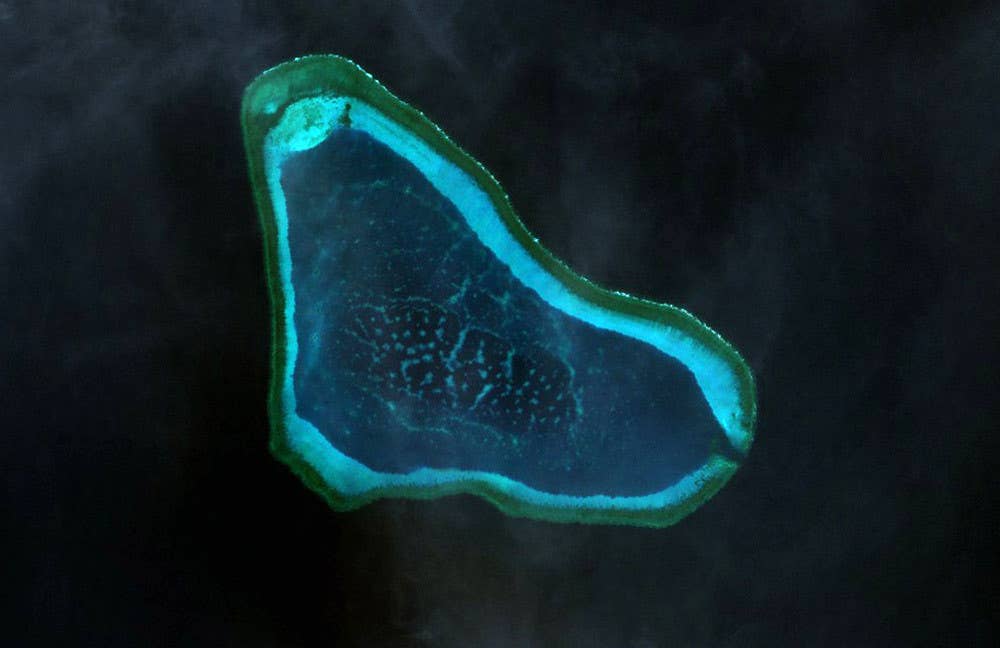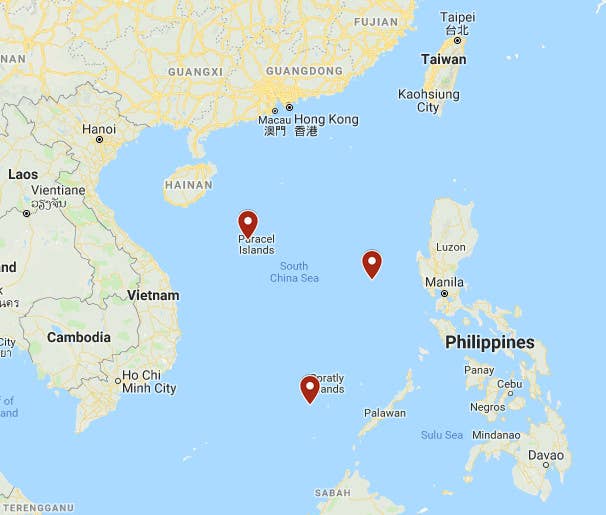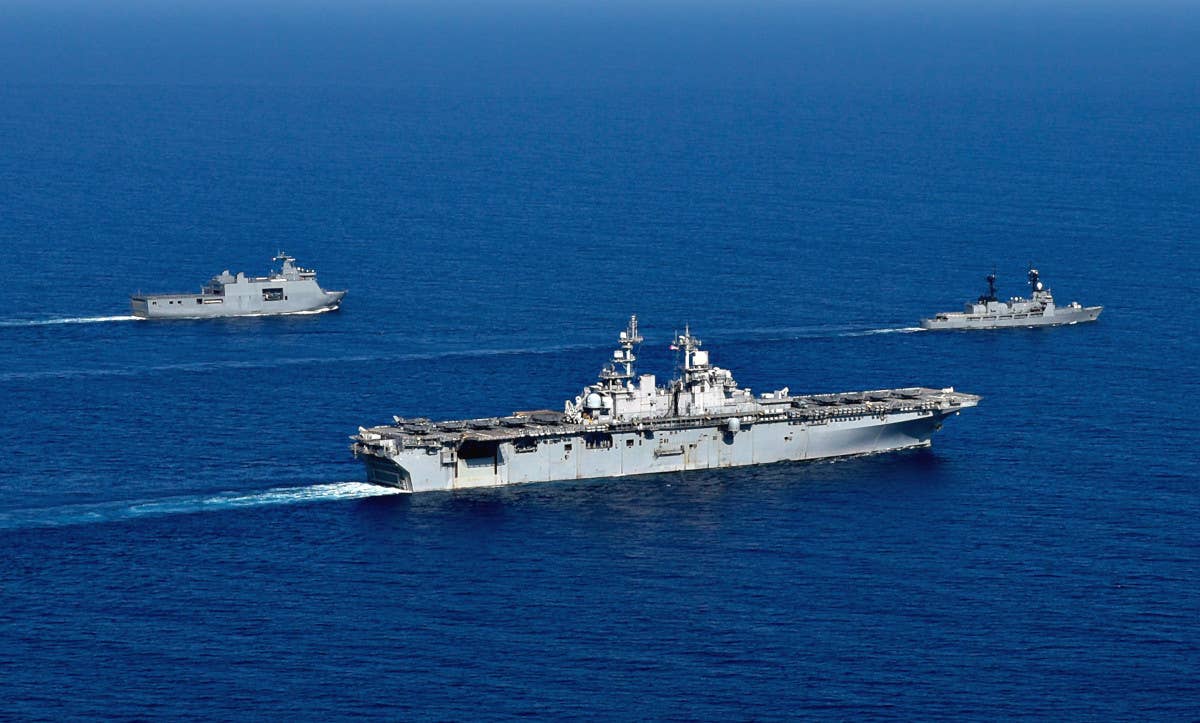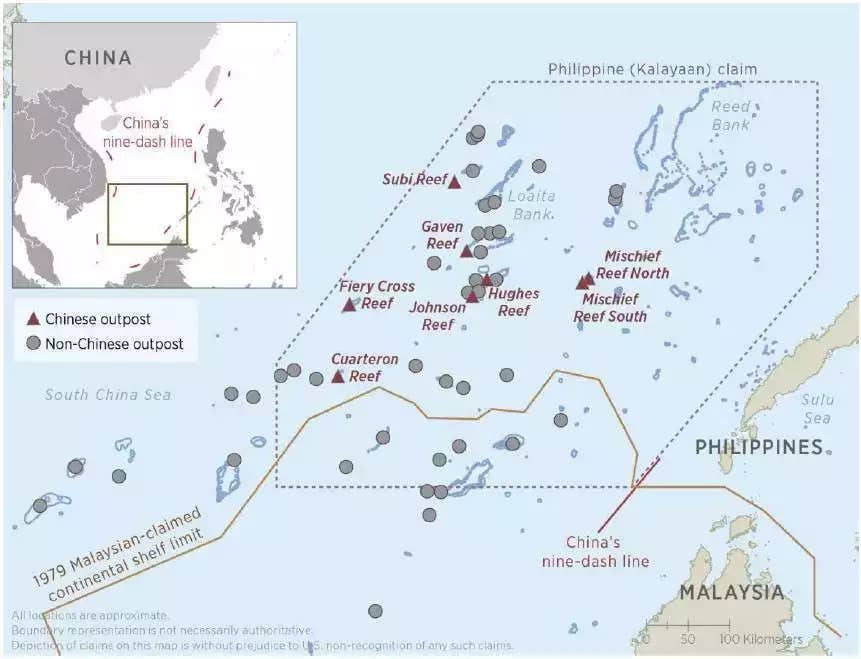China and the Philippines have competing claims to the area, which has turned into a major flashpoint in the past.

www.twz.com
Filipino fishermen have spotted the U.S. Navy amphibious assault ship USS Wasp sailing and conducting flight operations off the Scarborough Shoal in the South China Sea.
The vessel’s presence there, along with its unusually large complement of stealthy F-35B Joint Strike Fighters, is sure to irk China, which sees the area as a lynchpin in its larger efforts to assert control over the bulk of the region.
Fishing boats in the region first noticed the first-in-class Wasp near the shoal, which is at the heart of a long-running territorial dispute between Filipino and Chinese authorities, on Apr. 9, 2019, according to Filipino media outlet ABS-CBN.
The amphibious assault ship has been in the South China Sea since March 2019 and arrived in the Philippines on Mar. 30, 2019, to take part in the annual Exercise Balikatan. This is the first time F-35s of any kind have taken part in these drills.
Wasp had already drawn attention after pictures showed it carrying at least 10 F-35Bs, a significantly larger fixed wing force than ships of this class normally deploy with.
The U.S. Marine Corps and the Navy have been working for years to examine new concepts of operation for Marine air combat elements, or ACEs, equipped, in part, with Joint Strike Fighters when embarked on amphibious assault ships, which you can read about in more detail here.
The force of at least 10 F-35Bs from Marine Fighter Attack Squadron One Two One (VMFA-121) that are onboard Wasp now reflects proposals that could turn amphibious assault ships effectively into light aircraft carriers, if necessary, during major conflicts.
“Together they [Wasp and the F-35Bs] represent an increase in military capability committed to a free and open Indo-Pacific region,” the Navy said in an official statement regarding the exercise.
“Participating in Balikatan demonstrates their ability to quickly forward deploy in support of an ally should a crisis or natural disaster occur.”
Even before arriving near the disputed Scarborough Shoal, the comment about a “free and open” region had already seemed directed at the Chinese, in particular.
For years now, China has physically occupied a number of shoals and reefs in the South China Sea and has worked to turn them into man-made military outposts equipped with airfields capable of support heavy combat aircraft and port facilities to enable local naval operations.
The Chinese have also deployed shore-based anti-ship cruise missiles and long-range surface-to-air missiles on these artificial islands to challenge the ability of outside actors, including the United States, to operate freely in the region.
Full, uncontested control of Scarborough Shoal could give the Chinese a “strategic triangle,” with the other major points being Woody Island to the northwest in the Paracel Island chain and a cluster of outposts in the Spratly Islands to the south.
Aircraft and ships operating from these islands, along with shore-based defenses, would offer overlapping coverage and present a major threat to any potential opponent trying to move through the region during a crisis.

A satellite image of Scarborough Shoal as it existing 2000., NASA

A general map of China’s potential “strategic triangle” in the South China Sea, consisting of Woody Island to the northwest, various sites in the Spratly islands to the South, and Scarborough Shoal to the northeast, closer to the Philippines., Google
“China’s island-building and military activities in the South China Sea threaten your sovereignty, security, and therefore economic livelihood, as well as that of the United States,” U.S. Secretary of State Mike Pompeo told reporters in Manila during a visit on Mar. 1, 2019.
“Any armed attack on Philippine forces, aircraft or public vessels in the South China Sea will trigger mutual defense obligations.”
Wasp, with its F-35-heavy aviation component, certainly offers an American challenge to China’s regional claims and a clear demonstration of U.S. commitment to its alliance with the Philippines.
If the ship is conducting activities directly related to Exercise Balkistan, it could reflect a more active effort to use those drills to directly assert Filipino claims than in the past, when American and Filipino forces generally stayed clear of the disputed shoal itself.

The USS Wasp, with 10 F-35Bs visible on the deck, sails in the South China Sea with the Philippine Navy’s BRP Tarlac landing platform dock, at left, and BRP Ramon Alcaraz, an ex-US Coast Guard Hamilton-class cutter., USN
The area has already been hotly contested between China and the Philippines for years now. In 2012, Filipino Navy ships moved to arrest Chinese fishermen illegal operating within the Shoal’s lagoon, leading to a protracted standoff with Chinese “Marine Surveillance” vessels – now part of China’s Coast Guard – and elements of a paramilitary fishing fleet, which has since become commonly known as the “Little Blue Men.”
The latter is a reference to the “Little Green Men,” a mix of Russian special operations forces and local proxies, who appeared in Ukraine’s Crimea region in 2014 before Russia invaded and illegally annexed the peninsula.
The outcome of the standoff was embarrassing to the Philippines, who withdrew, effectively ceding control to the Chinese. Since then, China has continued to assert their authority over the area since and routinely chase Filipino fishermen away.
Wasp‘s appearance in the area is not the first time U.S. forces have made moves to dispute China’s control over Scarborough Shoal. In January 2018, the Arleigh Burke-class destroyer USS Hopper conducted a so-called Freedom of Navigation Patrol, or FONOP, near the shoal.
In April 2016, U.S. Air Force A-10 Warthog ground attack aircraft on a rotational deployment to the Philippines had also flown a mission over the contested area. China responded angrily in both cases, declaring that the United States had violated its sovereignty.
Still, how China might react now to Wasp operating in the vicinity of the Shoal isn’t clear. Chinese forces have been increasingly aggressive throughout the South China Sea, even toward American ships, since the beginning of 2018.
At the same time, after taking office in 2016, Philippine President Rodrigo Duterte had also pledged to largely drop the Scarborough Shoal issue, so long as China did not try to further expand its physical presence there, in favor of improving ties with Beijing.
However, in recent months, Duterte has faced increasing criticism for his stance toward China and its aggressive actions in the region.
Just days ago, the Philippine military said that Chinese Coast Guard vessels and Little Blue Men had “swarmed” Pag-asa Island in the Spratly chain, which the Philippines occupies with its own military garrison, prompting an unusually strong response from the Filipino president.

A map of Chinese military outposts in the Spratly island chain. Pag-asa is situated just to the northeast of Subi Reef., DOD
“I will not plead or beg, but I am just telling you that lay off the Pag-asa because I have soldiers there,” Duterte said on Apr. 4, 2019. “If you touch it, that’s another story. Then I will tell my soldiers ‘prepare for suicide missions’.”
The United States and China are also in the midst of a protracted trade war, rising tensions over Chinese threats toward Taiwan, and other disputes beyond the South China Sea.
So, with Chinese ties with the Philippines cooling off, and a chill in relations between Beijing and Washington, it remains to be seen how China will react, directly or indirectly, to Wasp‘s sudden appearance with its contingent of F-35Bs near the Scarborough Shoal.





